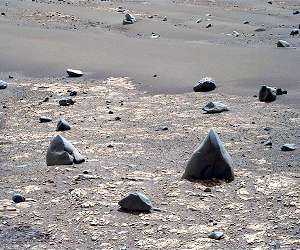After scraping away the top few layers of stone using its abrading bit, the Perseverance rover has revealed a network of thin, white veins. Could these hold clues about ancient life?
Geological veins are mineral deposits that form when a pre-existing fracture within a rock is filled with a new mineral. They are exciting to planetary scientists because they often provide evidence of past water flow.
For example, many rocks are naturally porous. Gravity pulls water at the surface into these pores, where it then circulates through subterranean fractures and fissures, just like blood circulating in our veins. As the water circulates, it dissolves soluble minerals exposed along the fractures – minerals like rock salt (halite), quartz, carbonates, and sulfates.
These dissolved minerals are carried by the fluid, sometimes great distances, before eventually re-solidifying, perhaps along the crack walls (like hard-water deposits forming on the inside of pipes) or in larger void spaces.
The veins discovered by Perseverance at its most recent workspace, an outcrop called Hidden Harbor, were found within a fractured sedimentary rock that itself probably formed in an ancient lake. This was an exciting find because the veins are strikingly different than the sedimentary rock surrounding them, suggesting that they formed at a different time and under different conditions.
This single slab of rock has preserved evidence of at least two different episodes of water activity on Mars: the first episode hardened (or “cemented”) the lake sediments into sedimentary rock, the second formed the mineral veins within the rock’s fractures.
By studying the minerals in the surrounding rock, as well as those inside the veins, researchers may be able to reconstruct what these different ancient wet environments looked like and whether they were suitable for life.
It is even possible that, during crystallization, the minerals in the veins trapped a droplet or two of the ancient water that carried them through the network of fractures in the first place, providing a time capsule of Mars’ watery past. These trapped droplets are called “fluid inclusions” and are sometimes found in mineralized veins on Earth. What’s more, some fluid inclusions on Earth contain organic matter or microfossils, preserved for hundreds of millions of years.
Do the veins in Jezero contain such fluid inclusions? It’s possible, but we cannot know for certain until we bring a sample back to Earth for detailed analysis. That’s why we commanded the rover to sample the veined rocks at Hidden Harbor so that we could add this compelling rock to our sample collection.
Related Links
Perseverance Mars 2020
Mars News and Information at MarsDaily.com
Lunar Dreams and more
|
We need your help. The SpaceDaily news network continues to grow but revenues have never been harder to maintain. With the rise of Ad Blockers, and Facebook – our traditional revenue sources via quality network advertising continues to decline. And unlike so many other news sites, we don’t have a paywall – with those annoying usernames and passwords. Our news coverage takes time and effort to publish 365 days a year. If you find our news sites informative and useful then please consider becoming a regular supporter or for now make a one off contribution. |
||
|
SpaceDaily Contributor $5 Billed Once credit card or paypal |
SpaceDaily Monthly Supporter $5 Billed Monthly paypal only |
|

![]()
A picture is worth a thousand words
Pasadena CA (JPL) Nov 24, 2022
From the image Perseverance recently took at Yori Pass, we can see that there are gray rocks scattered on top of a tan colored rock surface below. What do these different colors tell us? As planetary geologists, our job is to figure out through physical and chemical observations the story that these rocks tell us about Yori Pass and its place within the delta in Jezero Crater. Color is one of the first clues we can use that might hint at how the rocks formed.
When we see different colors like in t … read more